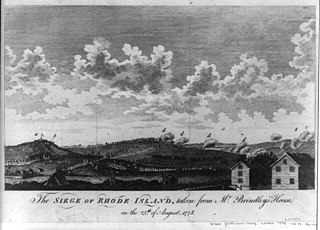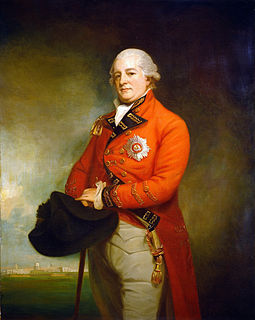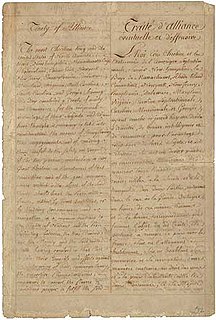 W
WThe Attack on German Flatts was a raid on the frontier settlement of German Flatts, New York during the American Revolutionary War. The attack was made by a mixed force of Loyalists and Iroquois under the overall command of Mohawk leader Joseph Brant, and resulted in the destruction of houses, barns, and crops, and the taking of livestock for the raiders' use. The settlers, warned by the heroic run of Adam Helmer, took refuge in local forts but were too militarily weak to stop the raiders.
 W
WThe Battle of Cobleskill was an American Revolutionary War raid on the frontier settlement of Cobleskill, New York on May 30, 1778. The battle, having taken place in the modern-day hamlet of Warnerville, New York, near the modern (2019) Cobleskill-Richmondville High School, marked the beginning of a phase in which Loyalists and Iroquois, encouraged and supplied by British authorities in the Province of Quebec, raided and destroyed numerous villages on what was then the United States western frontier of New York and Pennsylvania.
 W
WThe Battle of Crooked Billet was a battle in the Philadelphia campaign of the American Revolutionary War fought on May 1, 1778 near the Crooked Billet Tavern. In the skirmish action, British forces under the command of Major John Graves Simcoe launched a surprise attack against Brigadier General John Lacey and three regiments of Pennsylvania militia, who were literally caught sleeping. The British inflicted significant damage, and Lacey and his forces were forced to retreat into neighboring Bucks County.
 W
WThe Battle of Monmouth was fought near Monmouth Court House on June 28, 1778, during the American Revolutionary War. It pitted the Continental Army, commanded by General George Washington, against the British Army in North America, commanded by General Sir Henry Clinton.
 W
WThe Battle of Rhode Island took place on August 29, 1778. Continental Army and militia forces under the command of General John Sullivan had been besieging the British forces in Newport, Rhode Island, which is situated on Aquidneck Island, but they had finally abandoned their siege and were withdrawing to the northern part of the island. The British forces then sortied, supported by recently arrived Royal Navy ships, and they attacked the retreating Americans. The battle ended inconclusively, but the Continental forces withdrew to the mainland and left Aquidneck Island in British hands.
 W
WThe Battle of Wyoming was an encounter during the American Revolutionary War between American Patriots and Loyalists accompanied by Iroquois raiders which took place in the Wyoming Valley of Pennsylvania on July 3, 1778, in Exeter and Wyoming, Pennsylvania. More than 300 Patriots were killed in the battle.
 W
WThe Battle off Barbados was fought in March 1778 during the American Revolutionary War. While escorting a fleet of American ships in the West Indies, the frigate USS Randolph was attacked by the British ship-of-the-line HMS Yarmouth. The following action resulted in America's most costly naval defeat, in terms of human lives, until the sinking of USS Arizona in 1941.
 W
WThe "Baylor Massacre" was a surprise British attack on September 27, 1778, against the 3rd Regiment of Continental Light Dragoons under the command of Colonel George Baylor during the American Revolutionary War. It occurred in the present-day town of River Vale, New Jersey.
 W
WThe Big Runaway was a mass evacuation in June and July 1778 of settlers from the frontier areas of what is now north central Pennsylvania during the American Revolutionary War. A major campaign by Loyalists and Native Americans allied with the British devastated the small communities on the northern and western branches of the Susquehanna River, prompting local militia leaders to order the evacuation. Most of the settlers relocated to Fort Augusta at modern-day Sunbury at the confluence of the North and West Branches of the Susquehanna River, while their abandoned houses and farms were all burnt.
 W
WThe Capture of Savannah, or sometimes the First Battle of Savannah, or the Battle of Brewton Hill, was an American Revolutionary War battle fought on December 29, 1778 pitting local American Patriot militia and Continental Army units, holding the City, against a British invasion force under the command of Lieutenant Colonel Archibald Campbell. The British capture of the city led to an extended occupation and was the opening move in the British southern strategy to regain control of the rebellious Southern provinces by appealing to the relatively strong Loyalist sentiment there.
 W
WThe Carlisle Peace Commission was a group of British peace commissioners who were sent to North America in 1778 to negotiate terms with the rebellious Continental Congress during the American Revolutionary War. The commission carried an offer of self-rule, including parliamentary representation within the British Empire. The Second Continental Congress, aware that British troops were about to be withdrawn from Philadelphia, insisted on demanding full independence, which the commission was not authorised to grant.
 W
WThe Conway Cabal was a group of senior Continental Army officers in late 1777 and early 1778 who aimed to have George Washington replaced as commander-in-chief of the Army during the American Revolutionary War. It was named after Brigadier General Thomas Conway, whose letters criticizing Washington were forwarded to the Second Continental Congress. When these suggestions were made public, supporters of Washington mobilized to assist him politically. Conway ended up resigning from the army, and General Horatio Gates, a leading candidate to replace Washington, issued an apology for his role in events.
 W
WThe Culper Ring was an American Revolutionary War spy ring, organized by Major Benjamin Tallmadge and George Washington, set up in 1778 during the British occupation of New York City. The name "Culper" was suggested by George Washington, taken from Culpeper County, Virginia. The two leaders were Abraham Woodhull, and Robert Townsend, using the aliases of "Samuel Culper Sr.", and "Samuel Culper Jr.", respectively; Tallmadge was referred to as "John Bolton."
 W
WThe Illinois campaign, also known as Clark's Northwestern campaign (1778-1779), was a series of events during the American Revolutionary War in which a small force of Virginia militiamen, led by George Rogers Clark, seized control of several British posts in the Illinois Country, in what are now Illinois and Indiana in the Midwestern United States. The campaign is the best-known action of the western theater of the war and the source of Clark's reputation as an early American military hero.
 W
WMonmouth Battlefield State Park is a 1,818-acre (7.36 km2) New Jersey state park located on the border of Manalapan and Freehold Township, in Monmouth County, New Jersey, United States. This park preserves the historical battlefield on which the American Revolutionary War's Battle of Monmouth (1778) was waged.
 W
WThe Mount Hope Bay raids were a series of military raids conducted by British troops during the American Revolutionary War against communities on the shores of Mount Hope Bay on May 25 and 31, 1778. The towns of Bristol and Warren, Rhode Island were significantly damaged, and Freetown, Massachusetts was also attacked, although its militia resisted British attacks more successfully. The British destroyed military defenses in the area, including supplies that had been cached by the Continental Army in anticipation of an assault on British-occupied Newport, Rhode Island. Homes as well as municipal and religious buildings were also destroyed in the raids.
 W
WThe New World of the Western Hemisphere was devastated by the 1775–1782 North American smallpox epidemic. Columbus' first voyage to America can be attributed for bringing the smallpox virus to America and led to its spread across most of the continent of North America.
 W
WThe Raid on Unadilla and Onaquaga was a series of military operations by Continental Army forces and New York militia against the Iroquois towns of Unadilla and Onaquaga in what is now upstate New York. In early October 1778, more than 250 men under the command of Lieutenant Colonel William Butler of the 4th Pennsylvania Regiment descended on the two towns and destroyed them, razing most of the buildings and taking or destroying provisions, including the people's winter stores.
 W
WThe Siege of Boonesborough took place in September 1778 during the American Revolutionary War. The attack on the Kentucky settlement of Boonesborough was led by Chief Blackfish, a Shawnee leader allied to the British. Months before the battle, Blackfish had captured and adopted Daniel Boone, the founder of Boonesborough. Boone escaped the Shawnees in time to lead the defense of the settlement. Blackfish's siege was unsuccessful and was lifted after ten days. Boone was then court-martialed by fellow officers who suspected him of having British sympathies. Boone was acquitted, but he soon moved away from Boonesborough.
 W
WThe Treaty of Alliance or Franco-American Treaty was a defensive alliance between France and the United States of America, formed in the midst of the American Revolutionary War, which promised mutual military support in case fighting should break out between French and British forces, as the result of signing the previously concluded Treaty of Amity and Commerce. The alliance was planned to endure indefinitely into the future. Delegates of King Louis XVI of France and the Second Continental Congress, who represented the United States at this time, signed the two treaties along with a separate and secret clause dealing with future Spanish involvement, at the hôtel de Coislin in Paris on February 6, 1778. The Franco-American alliance would technically remain in effect until the 1800 Treaty of Mortefontaine, despite being annulled by the United States Congress in 1793 when George Washington gave his Neutrality Proclamation speech saying that America would stay neutral in the French Revolution.
 W
WThe Treaty of Amity and Commerce Between the United States and France, was the first of two treaties between the United States and France, signed on February 6, 1778, at the Hôtel de Coislin in Paris. Its sister treaty, the Treaty of Alliance were signed immediately thereafter. The Treaty of Amity and Commerce recognized the de facto independence of the United States and established a strictly commercial treaty between the two nations as an alternative to, and in direct defiance of, the British Acts of Trade and Navigation; the Treaty of Alliance, for mutual defense, was then signed "particularly in case Great Britain in Resentment of that connection and of the good correspondence which is the object of the [first] Treaty, should break the Peace with France, either by direct hostilities, or by hindering her commerce and navigation, in a manner contrary to the Rights of Nations, and the Peace subsisting between the two Crowns". These were the first treaties ever negotiated by the fledgling United States and signed in the midst of the American Revolutionary War. Due to later complications with the alliance treaty, America would not sign another military alliance until the Declaration by United Nations in 1942.
 W
WThe Treaty of Fort Pitt, also known as the Treaty With the Delawares, the Delaware Treaty, or the Fourth Treaty of Pittsburgh, was signed on September 17, 1778, and was the first written treaty between the new United States of America and any American Indians, in this case the Lenape. Although many informal treaties were held with Native Americans during the American Revolution from 1775 to 1783, the only one that resulted in a formal document was signed at Fort Pitt, Pennsylvania, now the site of Downtown Pittsburgh. It was essentially a formal treaty of alliance.